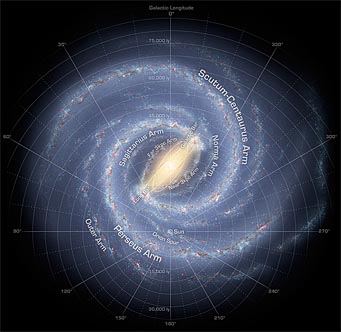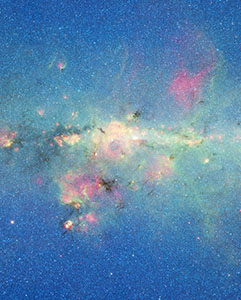
Artist's concept of the Milky Way's structure based on Spitzer survey. Click here for a larger image.
NASA / JPL-Caltech / R. Hurt
Our picture of where we're at in the cosmos is always getting refined as new information comes to light. The latest part of the picture to be revised is our map of the Milky Way galaxy. We reside in the thick of it, so it's tough to see the proverbial forest for the trees — especially because nearby interstellar dust blocks our view of most of the galaxy. New findings make a case that the Milky Way has a grand, simple structure of just two major spiral arms, along with two minor ones, rather than four equal ones as theorized in the past.
A team led by Robert Benjamin of the University of Wisconsin used the recently completed Spitzer Space Telescope mid-infrared survey of the Milky Way, which spans 130° of the galactic plane centered on the galaxy's center in Sagittarius. Mid-infrared light penetrates dust especially well.
Previous studies led astronomers to conclude the galaxy has a pronounced central bar and four major spiral arms, named for constellations where early researchers identified parts of them: Sagittarius, Scutum-Centaurus, Perseus, and Norma. Using software developed by Benjamin that counts stars and sorts them by their type and likely distances, the team mapped stellar distributions and noticed an increase in the number of stars where the Scutum-Centaurus Arm is thought to be. This agreed well with earlier studies.

The very center of the Milky Way as seen by NASA's Spitzer Space Telescope. The far-infrared wavelengths used penetrate all but the very densest dust clouds. Click here for a look at the entire mosaic.
NASA/JPL-Caltech/Univ. of Wisconsin
But when the team analyzed the areas of the Sagittarius and Norma arms, they saw no such big increase in stars. These two arms contain gas and clusters of young stars, while the Scutum-Centaurus arm consists of both young and old star populations.
What's more, the Scutum-Cen Arm connects nicely with one end of the galaxy's central bar, as does the Perseus arm with the other. In this picture, Sagittarius and Norma become mere "minor arms." Many other barred spiral galaxies have this structure, dominated by two spiral arms originating from the bar's ends.
Previous infrared studies hinted at the same arrangement, but uncertainties remained. Spitzer's superior results come from plotting the distribution of over 110 million stars, as well as the extent of gas and dust within 2° of the galactic plane. For more, see the team's press release.
However, a different team — mapping gas with data from the Far Infrared Absolute Spectrometer (FIRAS) aboard the Cosmic Background Explorer (COBE) satellite — claims that the Milky Way indeed has four large arms and that they are not identical in form, at least within 30° of the galactic center.
Team leader Thomas Steiman-Cameron of Indiana University says the conflict between these studies arises because the FIRAS data maps interstellar gas density (using ionized carbon and nitrogen atoms as tracers), whereas the Spitzer study maps both gas and stars. The actual difference between the four-arm and two-arm models may only be what each team defines as a full-fledged spiral arm.
Speaking of the Spitzer results: the survey is the largest, highest-resolution mid-infrared portrait of our galaxy ever done, consisting of more than 800,000 individual frames.
Beauty and Balance
Meanwhile, other astronomers annouce finding another piece of Milky Way symmetry. Some 50 years ago an inner "Expanding 3-kiloparsec Arm" was identified only 3 kiloparsecs (10,000 light-years) on our side of the galactic center. Now Tom Dame and Patrick Thaddeus (Harvard-Smithsonian Center for Astrophysics) find evidence for its far-side counterpart. The new "Far 3-kpc Arm" seems to be a twin of the near one. See press release.
And in other recent Milky Way mapping news, radio astronomers have measured parallaxes (distances) and velocities of young, maser-emitting stars scattered around the galaxy. These stars turn out to be on surprisingly elliptical galactic orbits, perhaps due to effects of today's spiral arms on star-forming gas clouds. See press release.
All these results were presented at the American Astronomical Society's semi-annual meeting earlier this month.
 0
0
Comments
You must be logged in to post a comment.